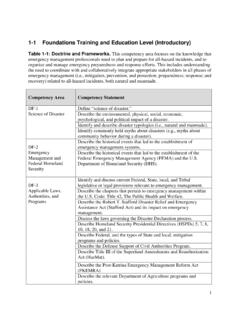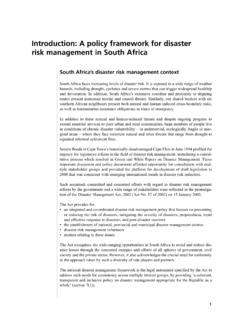Transcription of Kerala State Disaster Management Authority
1 Government of Kerala Kerala State Disaster Management Plan Profile Kerala State Disaster Management Authority 1. Table of Contents Chapter Title Page Foreword 3. I State Profile 5. II Hazard & Vulnerability Profile 10. III Prevention & Mitigation Measures 30. IV Policy, Institutional, Techno-Legal & Financial 44. Framework V Preparedness & Capacity Building Measures 50. VI State Response Plan 56. Annexure I Emergency Contact Numbers 66. 2. Foreword Kerala State is vulnerable in varying degrees to a large number of natural and man- made disasters of recurrent nature that result in loss of life, livelihoods, infrastructure and property, and cause immense hardships to the affected population, besides resulting in disruption of economic activity. The increasing vulnerabilities due to a variety of factors such as rapid urbanisation, environmental degradation, growing population and climate change compounded the Disaster risks in the State and this mandated a paradigm shift from a relief centric approach to a proactive and comprehensive mindset towards Disaster Management covering all aspects from prevention, mitigation, preparedness to response and recovery.
2 The enactment of Kerala State Disaster Management Rules, 2007 and promulgation of Kerala State Disaster Management Policy, 2010 in line with National DM Act, 2005 marked defining steps towards holistic Disaster Management in the State . The Disaster Management Act, 2005 provides that there shall be a plan for Disaster Management for every State to be called the State Disaster Management Plan and enjoins upon the State Government to make provisions for financing the activities to be carried out under the State Plan. While the process of hazard, vulnerability and risk analysis on which DM Plans should ideally be made has begun, it is highly felt that the preparation of plans should not await the outcome of risk analysis, rather it should be formulated on the basis of extant information and knowledge. Taking in to account past lessons and experiences and building on the good existing systems to further streamline them, a makeshift Disaster Management Plan for the State has been prepared by Department of Disaster Management .
3 The State Disaster Management Plan Profile launched herewith establishes operational and Management procedures for DM and include broad vulnerability of the State , strategies to be 3. adopted for the prevention and mitigation of disasters, capacity building measures to be taken and the roles and responsibilities of different Departments of the State in responding to threatening Disaster situations. Pending micro-level hazard, vulnerability and risk analysis and short, medium and long term structural and non-structural prevention and mitigation plans based on the outcome of the risk analysis may be incorporated in the plan later on to develop an holistic State Disaster Management Action Plan with financial arrangements to address all the hazards the State is vulnerable to. Dr. Nivedita P Haran IAS. Additional Chief Secretary Revenue and Disaster Management Kerala State 4. Chapter I.
4 State Profile Kerala , the Gods own country as it is popularly known, is a land blessed with natural resources. A narrow strip of land in the south-western margin of the Indian Peninsula, Kerala State is bounded by Western Ghats in the east and Arabian Sea in the west. On the longitudinal profile the land may be divided in to three zones, namely the high land, the mid land and the low land including the coastal plain. The State of Kerala consists of 14 Districts, 63 Taluks, 21 Revenue divisions, 152 Blocks, 999 Panchayaths and 1452 Villages. Kerala is home to of India's population. Kerala s rate of population growth is India's lowest, and Kerala 's population as per Census 2001 was lakh consisting of lakh males and lakh females. The sex ratio of Kerala has gradually increased from 1004:1000 in 1901 to 1028:1000 in 1951 and then to 1058:1000 in 2001. With 819. persons per km , it is nearly three times densely populated compared to the rest of India.
5 In Kerala , 74% of the population lives in rural areas. It is a noteworthy feature of Kerala that the percentage of aged population (above 60 years) is rising fast. Kerala 's human development indices primary level education, health care and elimination of poverty are among the best in India. Kerala has one of the highest literacy rates ( ) among Indian states and life expectancy (73 years) was among the highest in India. Kerala 's rural poverty rate fell from 69% (1970 1971) to 19% (1993 1994); the overall (urban and rural) rate fell 36% between the 1970s and 1980s. By 1999 2000, the rural and urban poverty rates dropped to substantially. Since independence, Kerala has been primarily welfare economy. Per-capita GSDP of the State is Rs. 11,819 (US$ ) which is above the Indian average. Kerala 's economy largely depends on emigrants working in foreign countries (mainly in the Gulf countries).
6 And the remittances annually contribute more than a fifth of GSDP. The service sector (including tourism, public administration, banking and finance, transportation, and communications) and the agricultural and fishing industries dominate the economy. Kerala has a tropical climate, the dominant climatic phenomena being the monsoons called the South-West (June to September) and the North-East (October to December). monsoons, the former is more significant than the latter with respect to the amount of rainfall 5. (80% of total rainfall). In Kerala , there are forty four (44) rivers, of which only three (3) are east flowing. Disaster Scenario in Kerala State The State s geographical location, weather pattern and high population density makes it prone to severe natural as well as human-induced disasters which can be countered only through organised mitigative actions. The State of Kerala is prone to a host of natural hazards such as coastal erosion, flood, drought, lightening, landslide and earthquake.
7 All most all districts of Kerala are multi-hazard prone (Figure I). In Kerala lightning, landslides (debris flows) and floods are the most commonly occurring natural hazards. Droughts and minor earth tremors also occur occasionally. The recent Tsunami of 26 December 2004 added a new dimension to the Disaster profile of the State . Kerala is prone to high incidence of lightning, especially during the months of April, May, October and November. It is estimated that about 70 people die every year due to lightning. About of the State is prone to flooding (CESS, 2010). Apart from floods the mountain regions of the State experience several landslides during the monsoon season. It is known that a total of 65 fatal landslides occurred between 1961 and 2009 causing the death of 257 individuals (Kuriakose, 2010). Between 1871-2000, the State experienced 12 moderate drought years. The 570 km long coast line of Kerala is prone to erosion, monsoon storm surges and sea level rise.
8 Land subsidence due to tunnel erosion or soil piping which is a slow hazard, is recently noticed to be affecting the hilly areas in the State . This often goes unnoticed and is a hazard with potential of causing landslides, infrastructural damages and crop loss covering vast areas in the high land regions of the State (Kuriakose, 2009). Kerala is also prone to several anthropogenic disasters such as road accidents, rail accidents, boat capsizing, industrial accidents, epidemics, pest infestation, stampedes, building collapses and fire accidents. As many of the dams in the State have exceeded their design life, they are potentially disastrous to people living in the downstream. Population pressure and unsustainable land use practices prevailing in the State are the main reason for many of the hazards to turn into Disaster events. Lack of proper infrastructure facilities and exceeding of carrying capacity are the cause of many of the anthropogenic hazards.
9 6. 7. Figure I : Multi-hazard zonation map of Kerala (CESS, 2010). Kerala is a place of high incidence of lightning compared to most of the other parts in India. Weather patterns and placement of Western Ghats together cause formation of more lightning clouds. Relatively higher population of more lightening higher population density and vegetation density result in more causality. Accidents caused by ground conduction from trees, which is a special feature of , May, October, November have relatively much higher lightning incidence. It is estimated that approximately 70 people die and property worth millions of rupees are damaged in the State annually due to lightning. Although the Kerala State does not experience floods as severe as in the Indo-Gangetic Plains, incidence of floods in the State is becoming more frequent and severe. High intensity of rainfall during the monsoons causes severe floods.
10 Increasing flood plain occupancy and reclamation of water bodies and wetlands results in increasing flood of the total area in the State is prone to flood. Kerala has been experiencing seasonal drought conditions every year during summer months. During the period 1871-2000 Kerala State experienced drought years out of which 12 each were moderate droughts. Increasing incidence of droughts is mainly due to weather anomalies change in land use, traditionl practices and life style of people. With a length of 570 km and covering about 15% of State s total area the coastal zone of Kerala is an important physiographic unit. Hazards in the coastal zone are erosion, monsoon, storm surges, sea level rise etc. More than 300 km of sea shore is erosion prone. Extensive sea wall construction along with gabion-box and groins has failed to arrest the erosion in many cases. The tsunami of 2004 which was experienced along most of the coastal regions of the State has added a new dimension to the Disaster scenario of the State .









